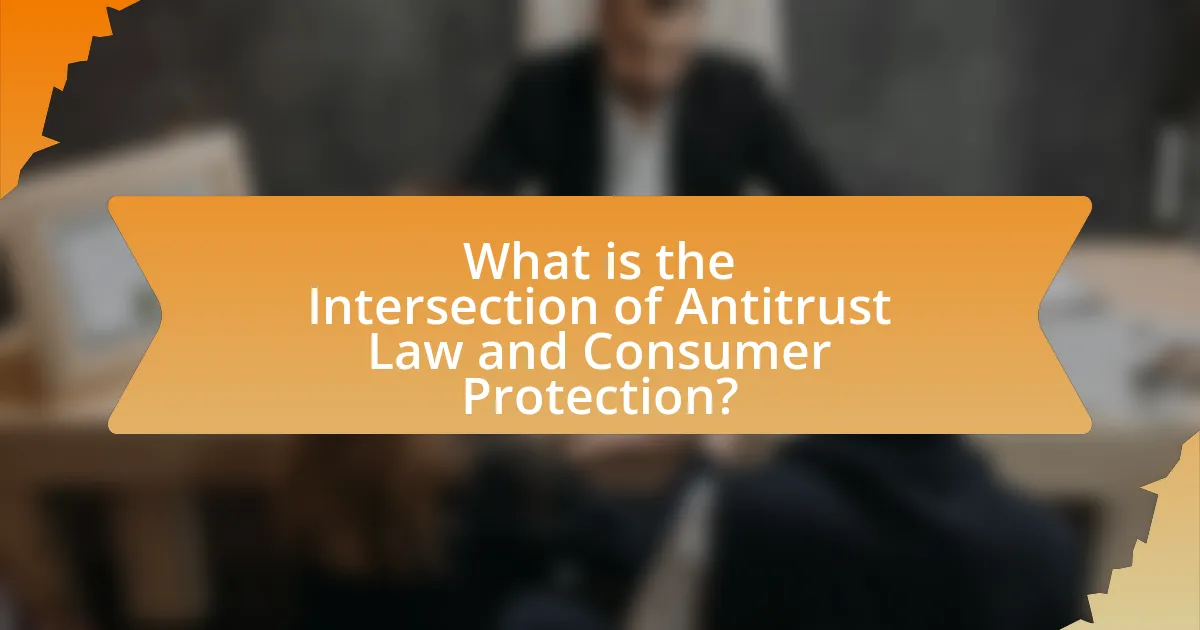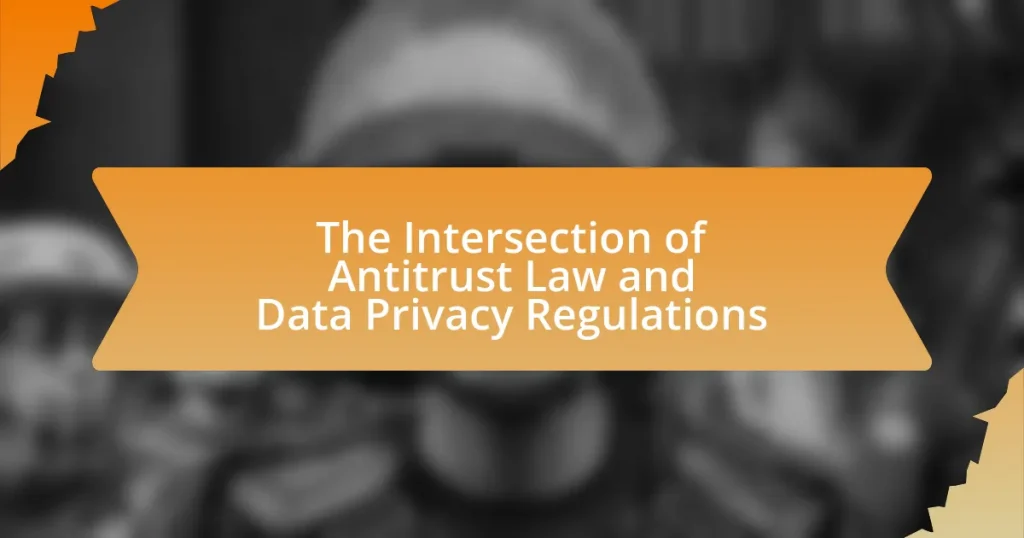The article examines the intersection of antitrust law and consumer protection, highlighting their shared objective of promoting fair competition and safeguarding consumer interests. It outlines the differences between antitrust laws, which focus on preventing monopolistic practices, and consumer protection laws, which aim to protect consumers from unfair business practices. Key goals of both legal frameworks are discussed, along with their historical developments, landmark cases, and the roles of regulatory agencies like the Federal Trade Commission and the Department of Justice. The article also addresses the challenges faced in enforcing these laws, the implications for consumers and businesses, and best practices for compliance, ultimately emphasizing the importance of their intersection in maintaining a competitive marketplace that benefits consumers.

What is the Intersection of Antitrust Law and Consumer Protection?
The intersection of antitrust law and consumer protection lies in their shared goal of promoting fair competition and safeguarding consumer interests. Antitrust law aims to prevent monopolistic practices and promote competition, which in turn benefits consumers through lower prices and improved quality of goods and services. Consumer protection laws focus on ensuring that consumers are treated fairly and are not subjected to deceptive practices. For example, the Federal Trade Commission (FTC) enforces both antitrust and consumer protection laws, highlighting their interconnectedness in maintaining a competitive marketplace that ultimately serves consumer welfare.
How do Antitrust Laws and Consumer Protection Laws differ?
Antitrust laws and consumer protection laws differ primarily in their focus and objectives. Antitrust laws aim to promote competition and prevent monopolistic practices that can harm the market structure, while consumer protection laws are designed to safeguard consumers from unfair, deceptive, or fraudulent business practices. For instance, the Sherman Act, a key antitrust law, prohibits monopolies and conspiracies that restrain trade, thereby ensuring a competitive marketplace. In contrast, the Federal Trade Commission Act enforces consumer protection by prohibiting unfair or deceptive acts affecting commerce, ensuring that consumers are treated fairly and honestly. This distinction highlights that antitrust laws prioritize market competition, whereas consumer protection laws prioritize individual consumer rights and welfare.
What are the primary goals of Antitrust Laws?
The primary goals of antitrust laws are to promote competition and prevent monopolistic practices. These laws aim to protect consumers by ensuring fair pricing, product quality, and innovation. For instance, the Sherman Act of 1890 prohibits contracts, combinations, or conspiracies that restrain trade, while the Clayton Act of 1914 addresses specific practices like price discrimination and exclusive dealings that may harm competition. By enforcing these regulations, antitrust laws help maintain a market environment where consumers benefit from a variety of choices and competitive prices.
What are the primary goals of Consumer Protection Laws?
The primary goals of Consumer Protection Laws are to safeguard consumers from unfair, deceptive, or fraudulent practices in the marketplace. These laws aim to ensure that consumers have access to accurate information about products and services, enabling informed purchasing decisions. Additionally, they seek to promote fair competition and prevent monopolistic behaviors that could harm consumers. For instance, the Federal Trade Commission Act of 1914 established the Federal Trade Commission to enforce consumer protection laws and promote competition, demonstrating the legal framework supporting these goals.
Why is the intersection of these two areas important?
The intersection of antitrust law and consumer protection is important because it ensures fair competition while safeguarding consumer interests. Antitrust laws prevent monopolistic practices that can lead to higher prices and reduced choices for consumers, while consumer protection laws address deceptive practices that can harm consumers. Together, they create a regulatory framework that promotes a competitive marketplace, ultimately benefiting consumers through lower prices and improved product quality. For instance, the Federal Trade Commission enforces both antitrust and consumer protection laws, demonstrating the necessity of their intersection in maintaining market integrity and consumer welfare.
How do they collectively impact market competition?
Antitrust law and consumer protection collectively impact market competition by promoting fair practices and preventing monopolistic behaviors. Antitrust laws, such as the Sherman Act, aim to dismantle monopolies and encourage competition, which leads to lower prices and improved product quality for consumers. Consumer protection laws, on the other hand, ensure that consumers are not misled or harmed by unfair business practices, fostering trust in the marketplace. Together, these legal frameworks create an environment where competition thrives, as evidenced by the increase in market entries and innovation in sectors where these laws are actively enforced. For instance, the Federal Trade Commission’s actions against deceptive advertising practices have led to a more informed consumer base, which in turn drives competition among businesses to meet consumer demands effectively.
What role do they play in safeguarding consumer rights?
Antitrust laws play a crucial role in safeguarding consumer rights by promoting competition and preventing monopolistic practices. These laws ensure that consumers have access to a variety of goods and services at fair prices, which is essential for maintaining a healthy marketplace. For instance, the Sherman Act of 1890 prohibits monopolies and attempts to monopolize, thereby protecting consumers from price-fixing and other anti-competitive behaviors. Additionally, the Federal Trade Commission enforces regulations that prevent deceptive practices, further ensuring that consumers are treated fairly and have accurate information when making purchasing decisions. This legal framework not only empowers consumers but also fosters innovation and economic growth by encouraging businesses to compete effectively.
What are the historical developments in Antitrust Law and Consumer Protection?
Antitrust law and consumer protection have evolved significantly since the late 19th century, primarily to address monopolistic practices and protect consumer interests. The Sherman Antitrust Act of 1890 marked the first federal legislation aimed at curbing monopolies and promoting competition in the United States. This was followed by the Clayton Antitrust Act of 1914, which further defined anti-competitive practices and included provisions for consumer protection.
In the mid-20th century, the Federal Trade Commission (FTC) was empowered to enforce consumer protection laws, leading to the Wheeler-Lea Act of 1938, which prohibited deceptive advertising practices. The 1970s saw a shift towards more aggressive enforcement of antitrust laws, with landmark cases like United States v. AT&T, which dismantled the telecommunications monopoly.
The late 20th and early 21st centuries introduced new challenges with the rise of digital markets, prompting regulatory bodies to adapt existing laws to address issues like data privacy and online monopolies. The enactment of the Consumer Product Safety Act in 1972 and the Fair Credit Reporting Act in 1970 further solidified consumer protection measures.
Overall, the historical developments in antitrust law and consumer protection reflect an ongoing effort to balance market competition with the safeguarding of consumer rights, adapting to changing economic landscapes and technological advancements.
How have landmark cases shaped these laws?
Landmark cases have significantly shaped antitrust laws and consumer protection by establishing legal precedents that define competitive practices and consumer rights. For instance, the Supreme Court case of United States v. Microsoft Corp. (2001) set a precedent for evaluating monopolistic behavior, leading to stricter scrutiny of corporate practices that harm competition and consumers. Additionally, the case of Brown v. Board of Education (1954) influenced consumer protection by reinforcing the principle that discriminatory practices are unlawful, thereby impacting how consumer rights are viewed in the context of antitrust regulations. These cases illustrate how judicial decisions can create frameworks that guide legislative and regulatory actions in both antitrust and consumer protection domains.
What legislative changes have influenced their intersection?
Legislative changes such as the introduction of the Consumer Protection Act and amendments to the Sherman Act have significantly influenced the intersection of antitrust law and consumer protection. The Consumer Protection Act, enacted to safeguard consumers from unfair business practices, complements antitrust laws by promoting competition and preventing monopolistic behaviors that can harm consumers. Additionally, amendments to the Sherman Act have expanded the scope of antitrust enforcement, allowing for more robust actions against anti-competitive practices that directly affect consumer welfare. These legislative frameworks work together to ensure that both competition and consumer rights are upheld in the marketplace.

How do Antitrust Law and Consumer Protection interact in practice?
Antitrust law and consumer protection interact by ensuring competitive markets while safeguarding consumer interests. Antitrust laws, such as the Sherman Act and the Clayton Act, prevent monopolistic practices and promote competition, which inherently benefits consumers through lower prices and improved quality. For instance, when companies engage in anti-competitive behavior, consumer protection agencies can step in to address the harm caused to consumers, such as price gouging or deceptive practices.
Moreover, both frameworks often collaborate; for example, the Federal Trade Commission (FTC) enforces both antitrust laws and consumer protection regulations, allowing for a comprehensive approach to market regulation. This dual enforcement helps to create a fair marketplace where consumers are not only protected from unfair practices but also benefit from the competitive dynamics fostered by antitrust laws.
What are the common challenges faced in enforcing these laws?
Common challenges in enforcing antitrust and consumer protection laws include the complexity of proving anti-competitive behavior, limited resources for regulatory agencies, and the rapid pace of technological change. Proving anti-competitive behavior often requires extensive economic analysis and evidence, which can be difficult to obtain. Regulatory agencies frequently face budget constraints and staffing shortages, limiting their ability to investigate and prosecute violations effectively. Additionally, the fast-evolving nature of technology and digital markets can outpace existing legal frameworks, making it challenging to apply traditional antitrust principles. These factors collectively hinder the effective enforcement of laws designed to protect consumers and promote fair competition.
How do conflicting interests arise between businesses and consumers?
Conflicting interests arise between businesses and consumers primarily due to differing priorities regarding profit maximization and consumer welfare. Businesses often prioritize maximizing profits, which can lead to practices such as price increases, reduced product quality, or misleading advertising, ultimately harming consumers. For instance, a study by the Federal Trade Commission in 2019 highlighted that companies may engage in deceptive marketing strategies to enhance sales, which can mislead consumers about product benefits. This misalignment of goals creates tension, as consumers seek fair prices and quality products, while businesses may focus on strategies that prioritize their financial gain over consumer satisfaction.
What are the limitations of current enforcement mechanisms?
Current enforcement mechanisms in antitrust law and consumer protection face several limitations, including insufficient resources, lack of coordination among agencies, and outdated legal frameworks. Insufficient resources hinder the ability of enforcement agencies to investigate and prosecute cases effectively, as seen in the Federal Trade Commission’s budget constraints, which limit its capacity to address complex antitrust issues. Lack of coordination among agencies, such as the Federal Trade Commission and the Department of Justice, can lead to fragmented enforcement efforts, resulting in inconsistent outcomes. Additionally, outdated legal frameworks struggle to address modern market dynamics, particularly in digital markets, where traditional antitrust principles may not adequately capture anti-competitive behaviors. These limitations collectively undermine the effectiveness of enforcement mechanisms in promoting fair competition and protecting consumers.
How do regulatory agencies approach the intersection?
Regulatory agencies approach the intersection of antitrust law and consumer protection by implementing policies that promote competition while safeguarding consumer interests. These agencies, such as the Federal Trade Commission (FTC) and the Department of Justice (DOJ), analyze market practices to prevent anti-competitive behavior that could harm consumers. For instance, the FTC has the authority to challenge mergers that may reduce competition and lead to higher prices or lower quality products, as seen in the 2018 challenge against the merger of two pharmaceutical companies, which was based on potential harm to consumers. This dual focus ensures that while businesses can compete effectively, consumers are also protected from unfair practices and monopolistic behaviors.
What roles do the Federal Trade Commission and Department of Justice play?
The Federal Trade Commission (FTC) and the Department of Justice (DOJ) are the primary federal agencies responsible for enforcing antitrust laws in the United States. The FTC focuses on preventing unfair methods of competition and deceptive practices, while the DOJ prosecutes antitrust violations and reviews mergers and acquisitions to ensure they do not substantially lessen competition. For instance, the DOJ’s Antitrust Division has successfully challenged major mergers, such as the 2018 AT&T-Time Warner merger, asserting that it would harm competition and consumers. Together, these agencies work to promote fair competition and protect consumer interests, ensuring a balanced marketplace.
How do state laws complement federal regulations?
State laws complement federal regulations by filling gaps, addressing local concerns, and providing additional protections that enhance consumer welfare. For instance, while federal antitrust laws focus on preventing monopolistic practices, state laws can impose stricter regulations on business practices within their jurisdictions, thereby ensuring a more tailored approach to consumer protection. This dual-layered regulatory framework allows states to respond to specific market conditions and consumer needs, as seen in states like California, which has enacted laws that go beyond federal standards to protect consumers from unfair business practices.

What are the implications of the intersection for consumers and businesses?
The intersection of antitrust law and consumer protection has significant implications for both consumers and businesses. For consumers, enhanced antitrust enforcement can lead to lower prices, improved product quality, and greater choice, as it aims to prevent monopolistic practices that limit competition. For businesses, stricter antitrust regulations may require them to adapt their practices to avoid legal repercussions, potentially leading to increased operational costs and the need for compliance strategies. This dynamic can foster innovation as companies strive to differentiate themselves in a competitive market. Historical data shows that regions with robust antitrust enforcement, such as the United States, have experienced more competitive markets, benefiting consumers through lower prices and better services.
How does this intersection affect consumer choices?
The intersection of antitrust law and consumer protection significantly influences consumer choices by promoting competition and preventing monopolistic practices. When antitrust laws are effectively enforced, they ensure that consumers have access to a variety of products and services at competitive prices, which empowers them to make informed decisions. For instance, the Federal Trade Commission’s actions against companies that engage in anti-competitive behavior, such as price-fixing or market manipulation, directly enhance consumer welfare by fostering an environment where multiple options are available. This increased competition not only leads to better prices but also encourages innovation, ultimately benefiting consumers through improved quality and variety of goods and services.
What protections do consumers gain from Antitrust enforcement?
Consumers gain protections from antitrust enforcement through the promotion of competition, which leads to lower prices, improved quality, and greater innovation. Antitrust laws prevent monopolistic practices and anti-competitive behavior, ensuring that no single entity can dominate the market to the detriment of consumers. For example, the Sherman Act of 1890 and the Clayton Act of 1914 are foundational laws that prohibit practices such as price-fixing and market allocation, which can harm consumer interests. By enforcing these laws, regulatory bodies like the Federal Trade Commission and the Department of Justice work to maintain a competitive marketplace, ultimately benefiting consumers through fairer pricing and more choices.
How do businesses adapt to comply with both sets of laws?
Businesses adapt to comply with both antitrust laws and consumer protection laws by implementing comprehensive compliance programs that address the requirements of each legal framework. These programs typically include regular training for employees on legal standards, monitoring business practices to ensure fair competition, and establishing clear protocols for handling consumer complaints. For instance, companies often conduct audits to assess compliance with antitrust regulations while simultaneously ensuring that marketing practices do not mislead consumers, thereby fulfilling obligations under consumer protection laws. This dual approach not only mitigates legal risks but also enhances corporate reputation and consumer trust.
What best practices can businesses adopt to navigate this intersection?
Businesses can adopt several best practices to navigate the intersection of antitrust law and consumer protection effectively. First, they should implement robust compliance programs that educate employees about antitrust regulations and consumer protection laws, ensuring that all levels of the organization understand their legal obligations. For instance, the Federal Trade Commission emphasizes the importance of training to prevent deceptive practices and promote fair competition.
Second, businesses should conduct regular audits of their marketing and sales practices to identify potential violations of antitrust laws and consumer protection standards. This proactive approach can help mitigate risks associated with anti-competitive behavior and misleading advertising.
Third, fostering transparency in pricing and business practices can enhance consumer trust and reduce the likelihood of regulatory scrutiny. Research shows that companies that prioritize transparency often experience higher customer loyalty and satisfaction.
Lastly, engaging with legal experts who specialize in antitrust and consumer protection can provide businesses with tailored strategies to navigate complex regulations effectively. This expert guidance can help businesses stay informed about changes in the legal landscape and adapt their practices accordingly.
How can businesses ensure compliance with Antitrust and Consumer Protection laws?
Businesses can ensure compliance with Antitrust and Consumer Protection laws by implementing robust compliance programs that include regular training, monitoring, and audits. These programs should educate employees about the legal standards and practices related to fair competition and consumer rights. For instance, the Federal Trade Commission (FTC) emphasizes the importance of understanding deceptive practices and anticompetitive behavior, which can lead to significant penalties if violated. Additionally, businesses should establish clear reporting mechanisms for potential violations and conduct regular assessments of their business practices to identify and mitigate risks. By adhering to these practices, companies can align their operations with legal requirements and protect themselves from legal repercussions.
What strategies can enhance consumer trust while maintaining competition?
Enhancing consumer trust while maintaining competition can be achieved through transparency, ethical marketing practices, and robust customer service. Transparency involves clear communication about product features, pricing, and data usage, which fosters trust; for instance, companies that disclose their data privacy policies tend to have higher consumer confidence. Ethical marketing practices, such as avoiding misleading advertisements, ensure that consumers make informed choices, thereby reinforcing trust without stifling competition. Additionally, providing exceptional customer service, including responsive support and effective complaint resolution, builds loyalty and trust among consumers, as evidenced by studies showing that 70% of consumers are willing to pay more for better customer service. These strategies collectively promote a competitive environment while enhancing consumer trust.



